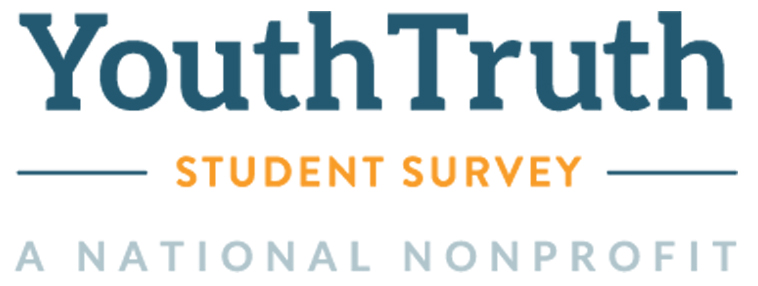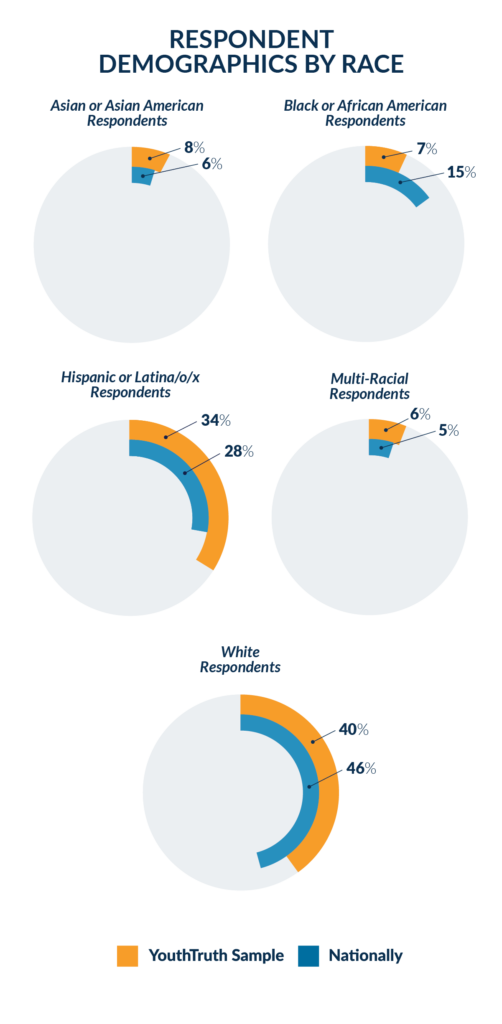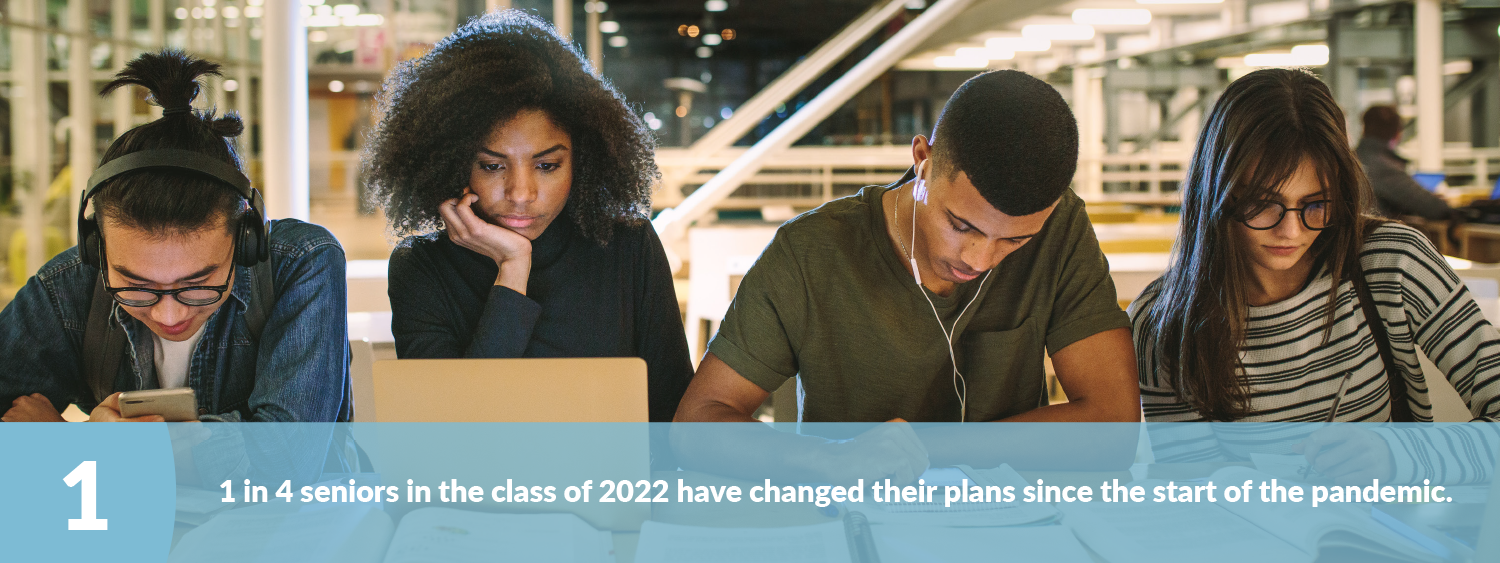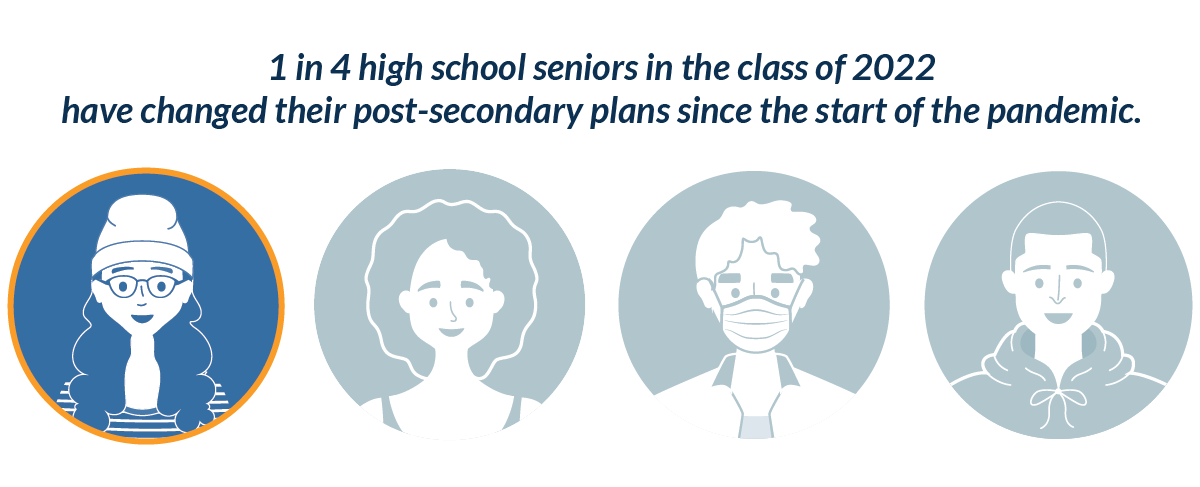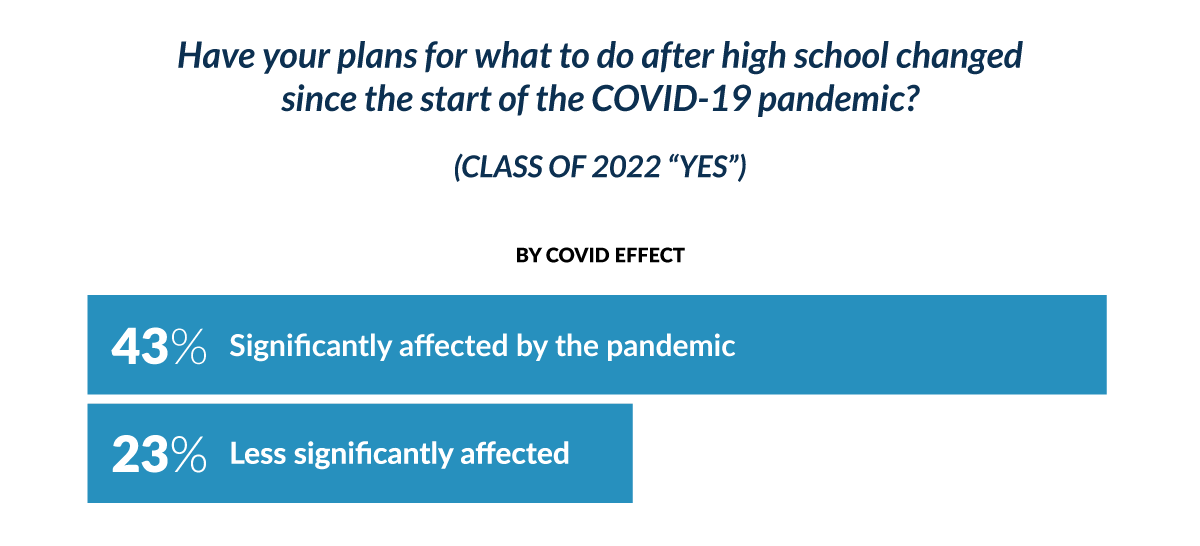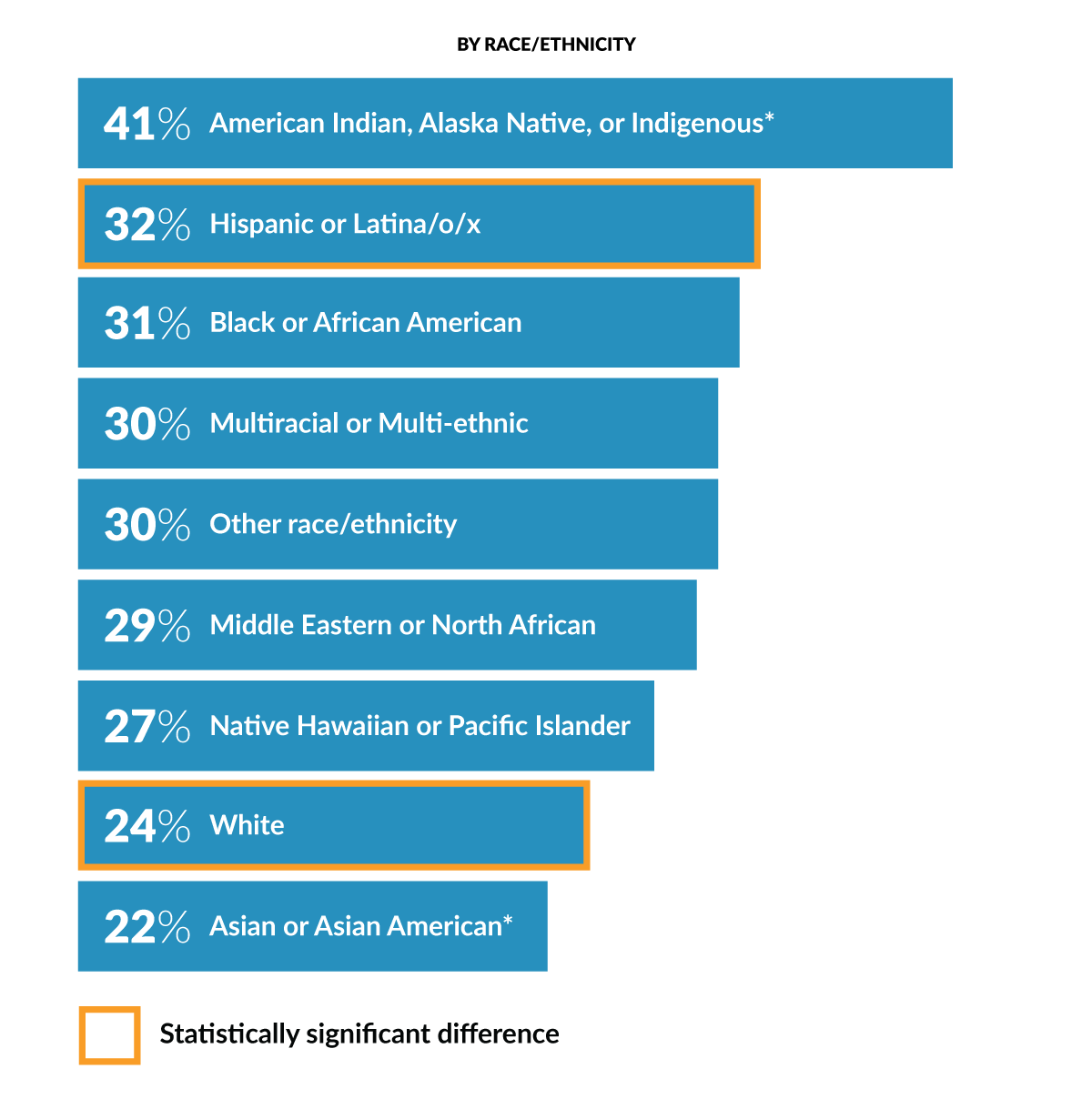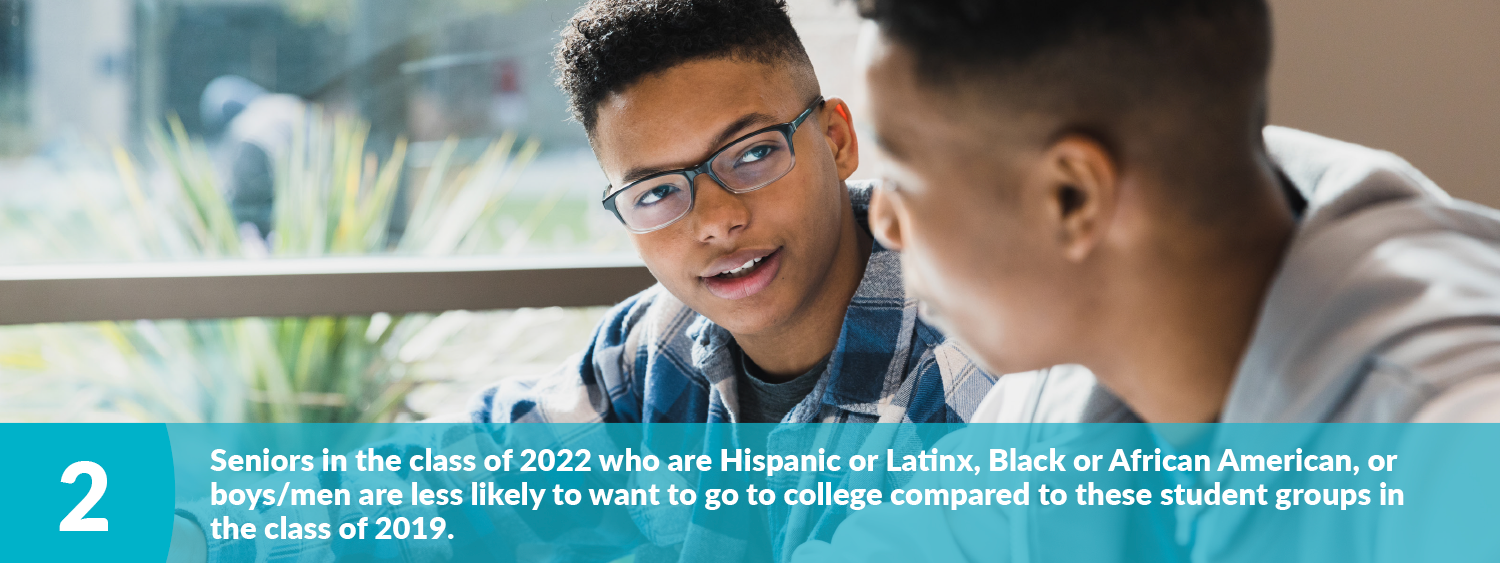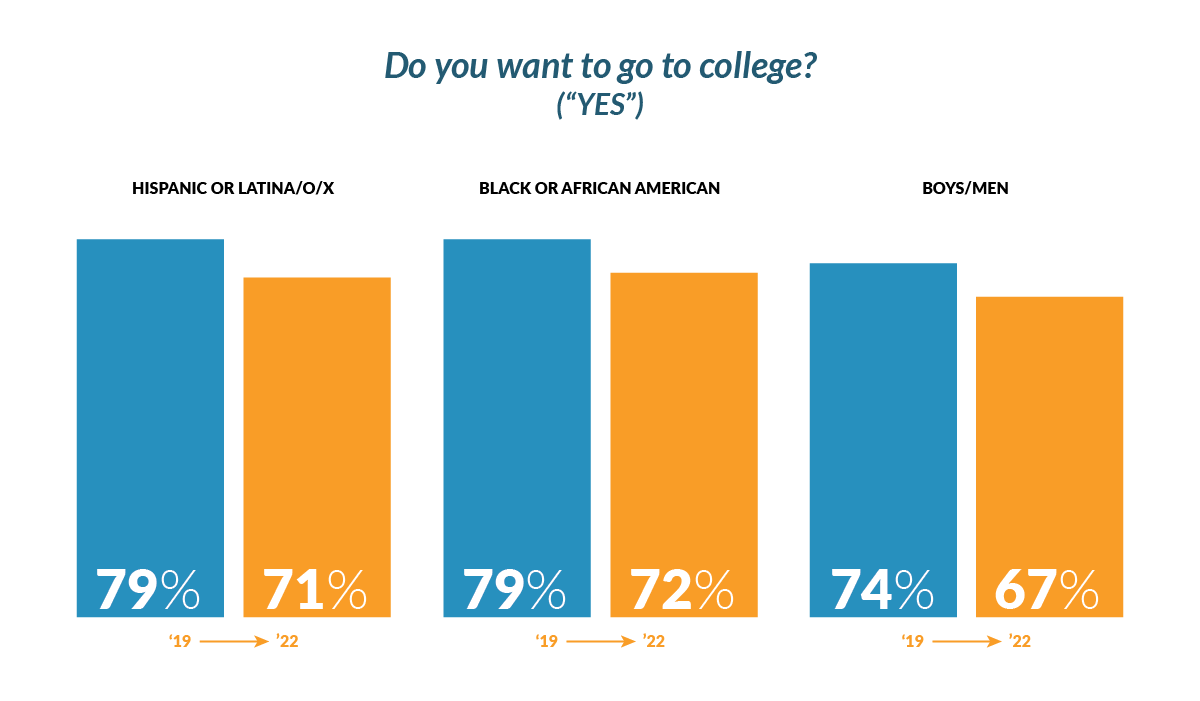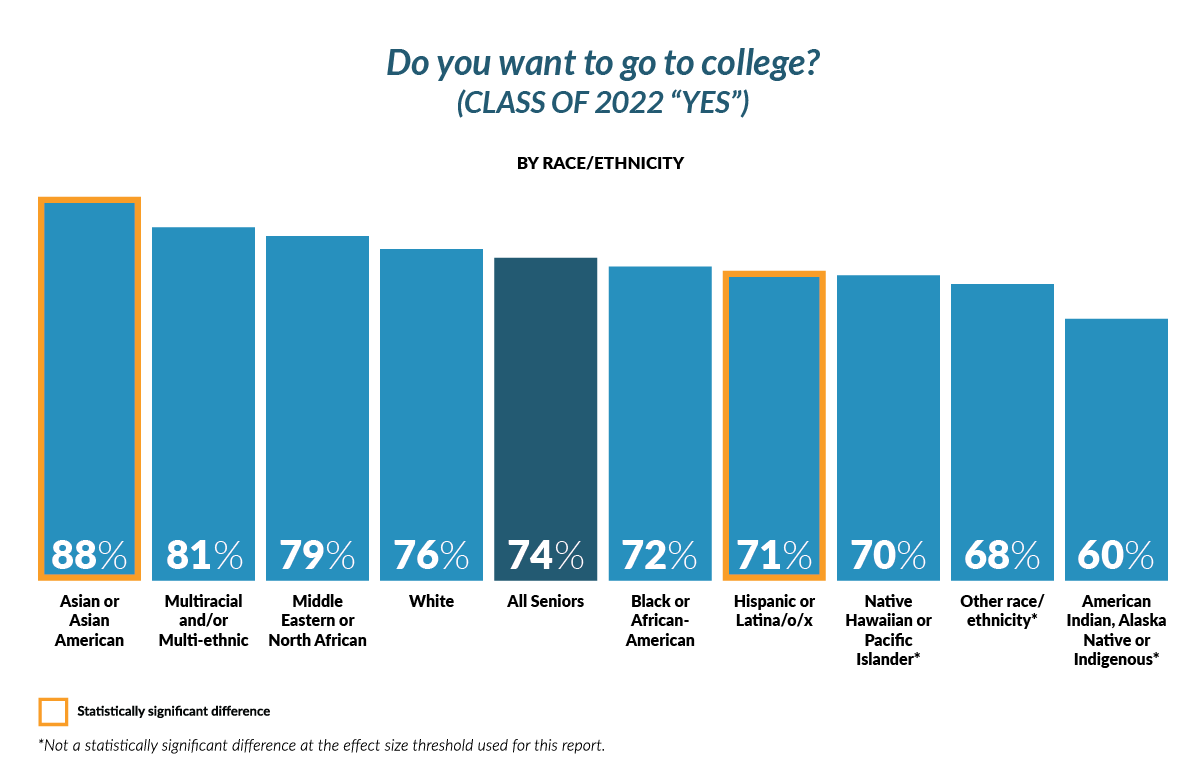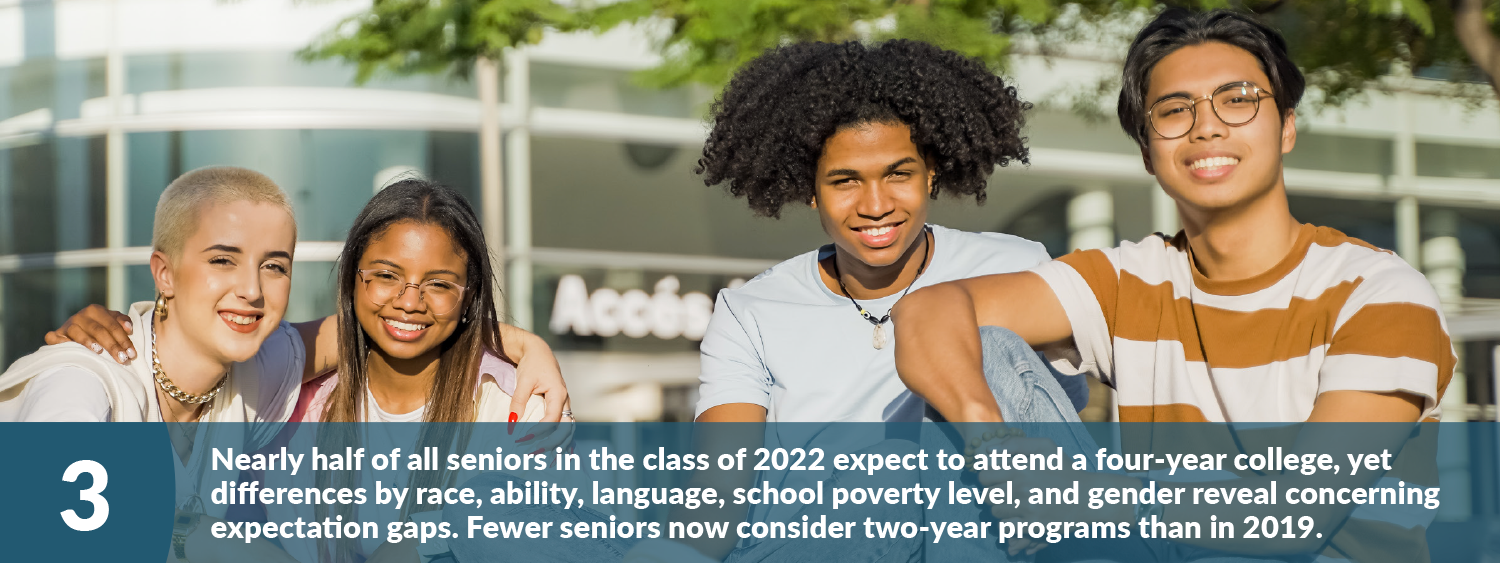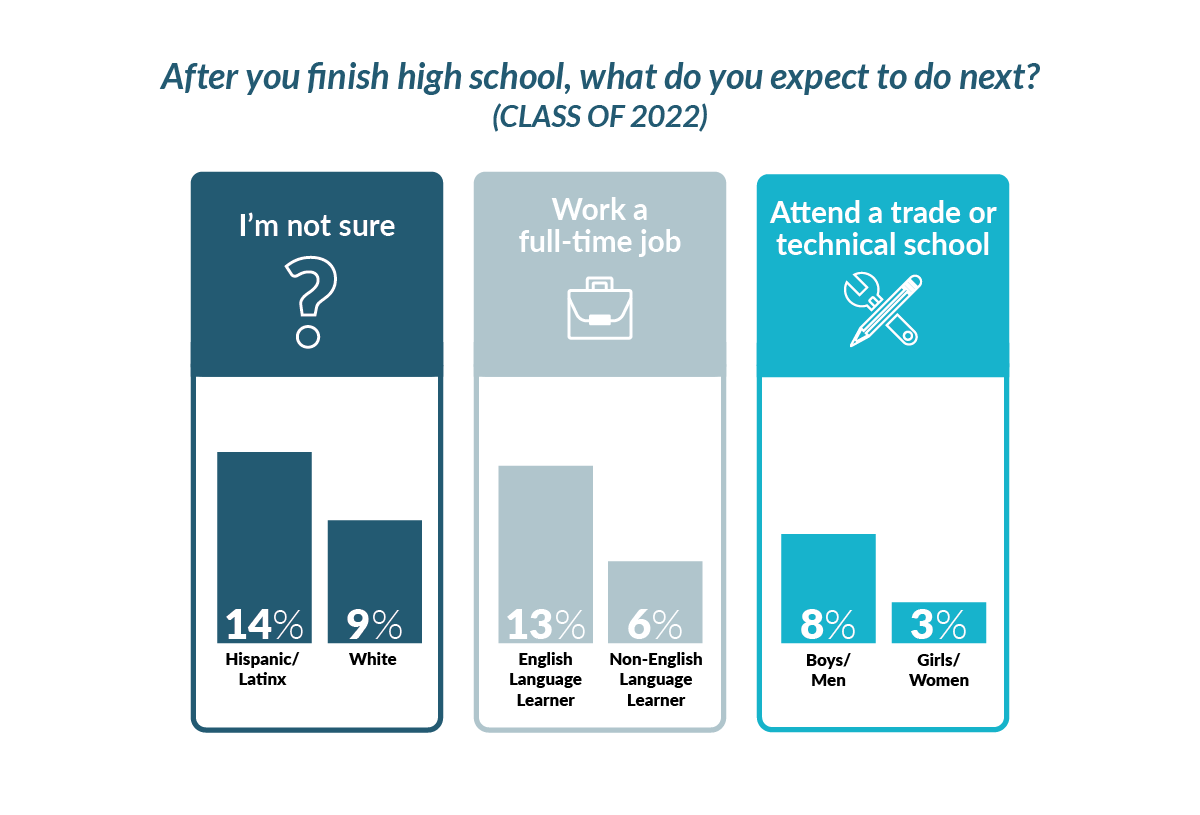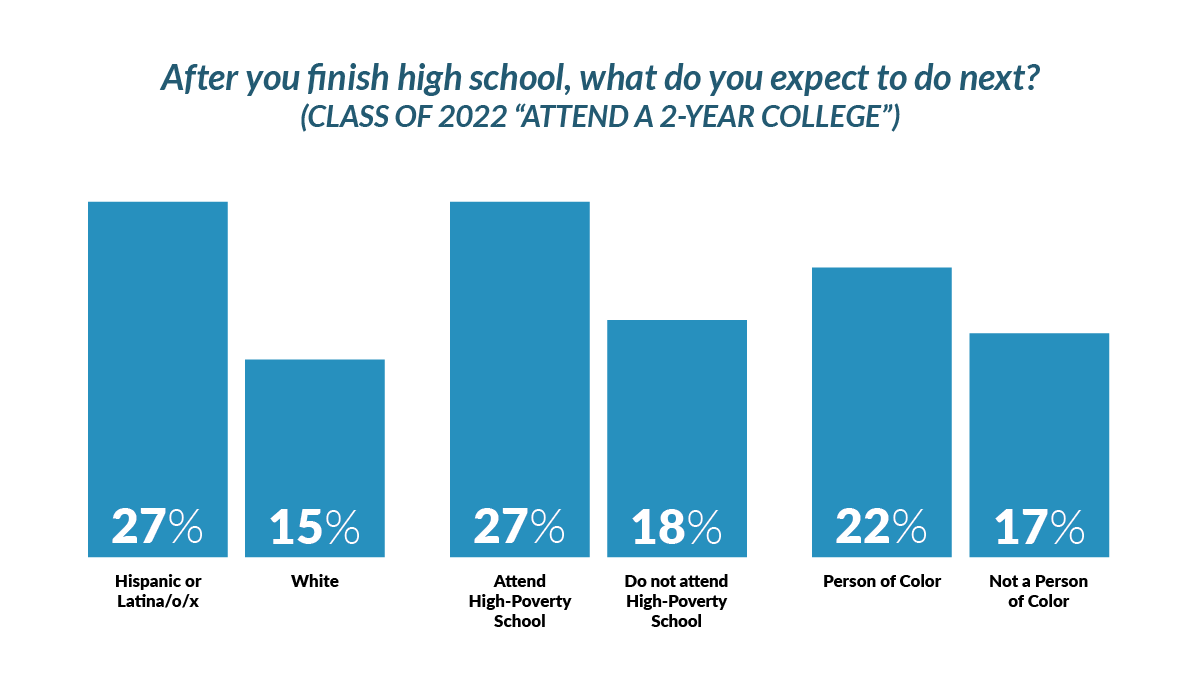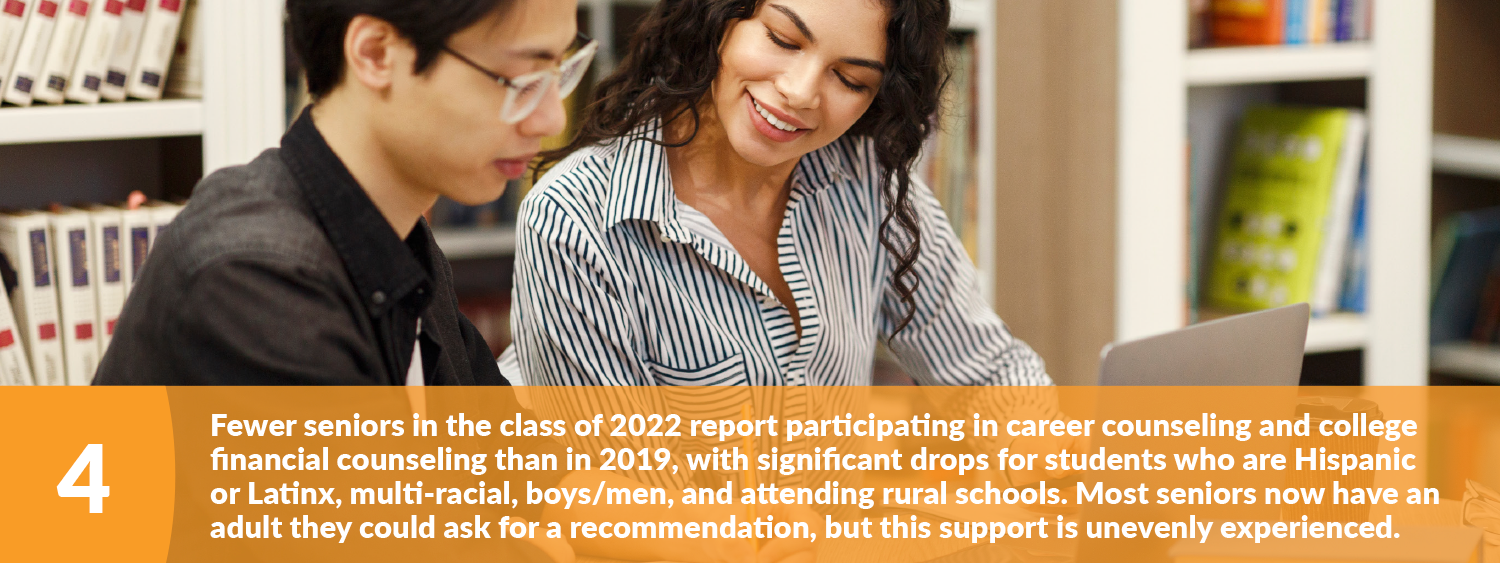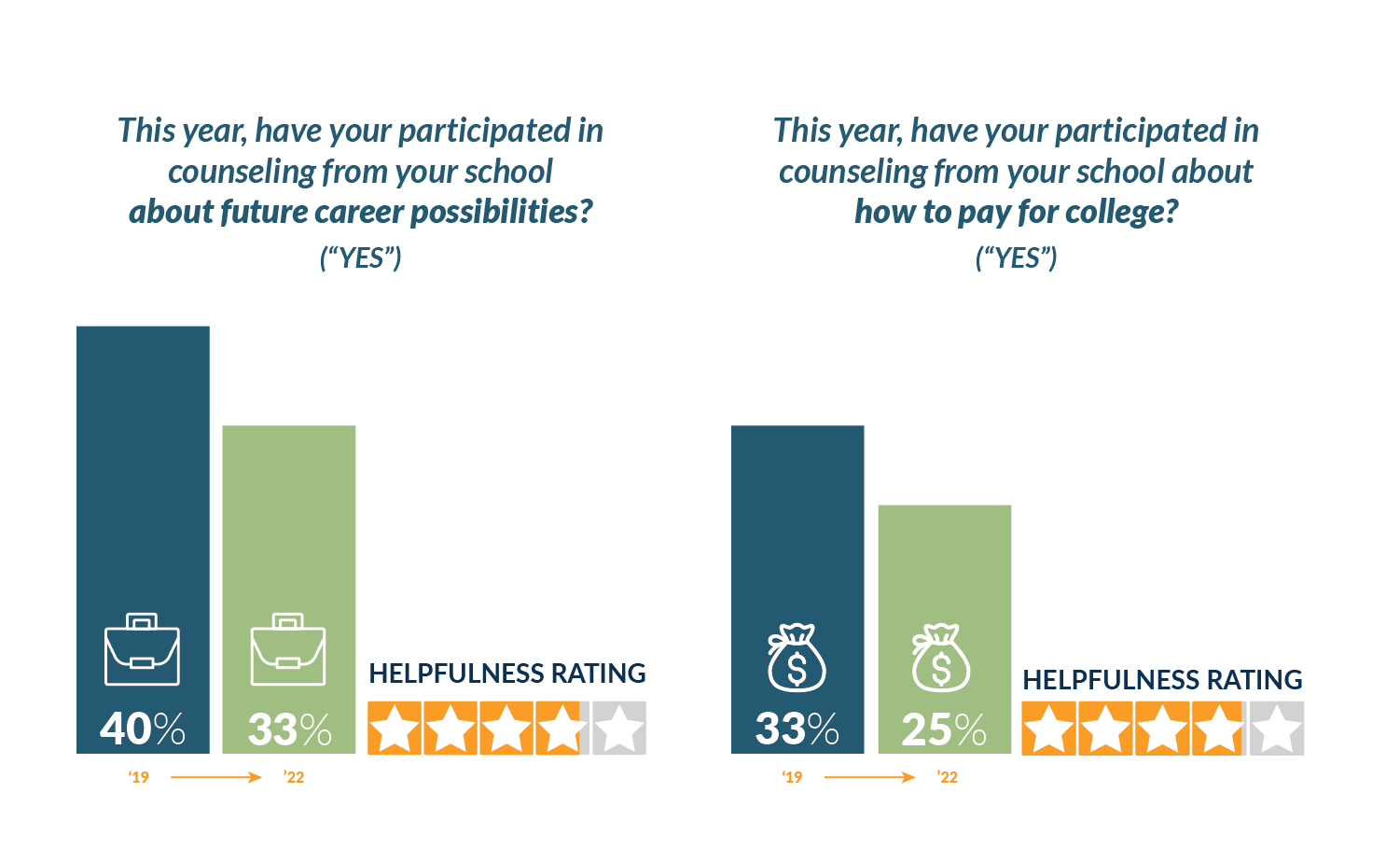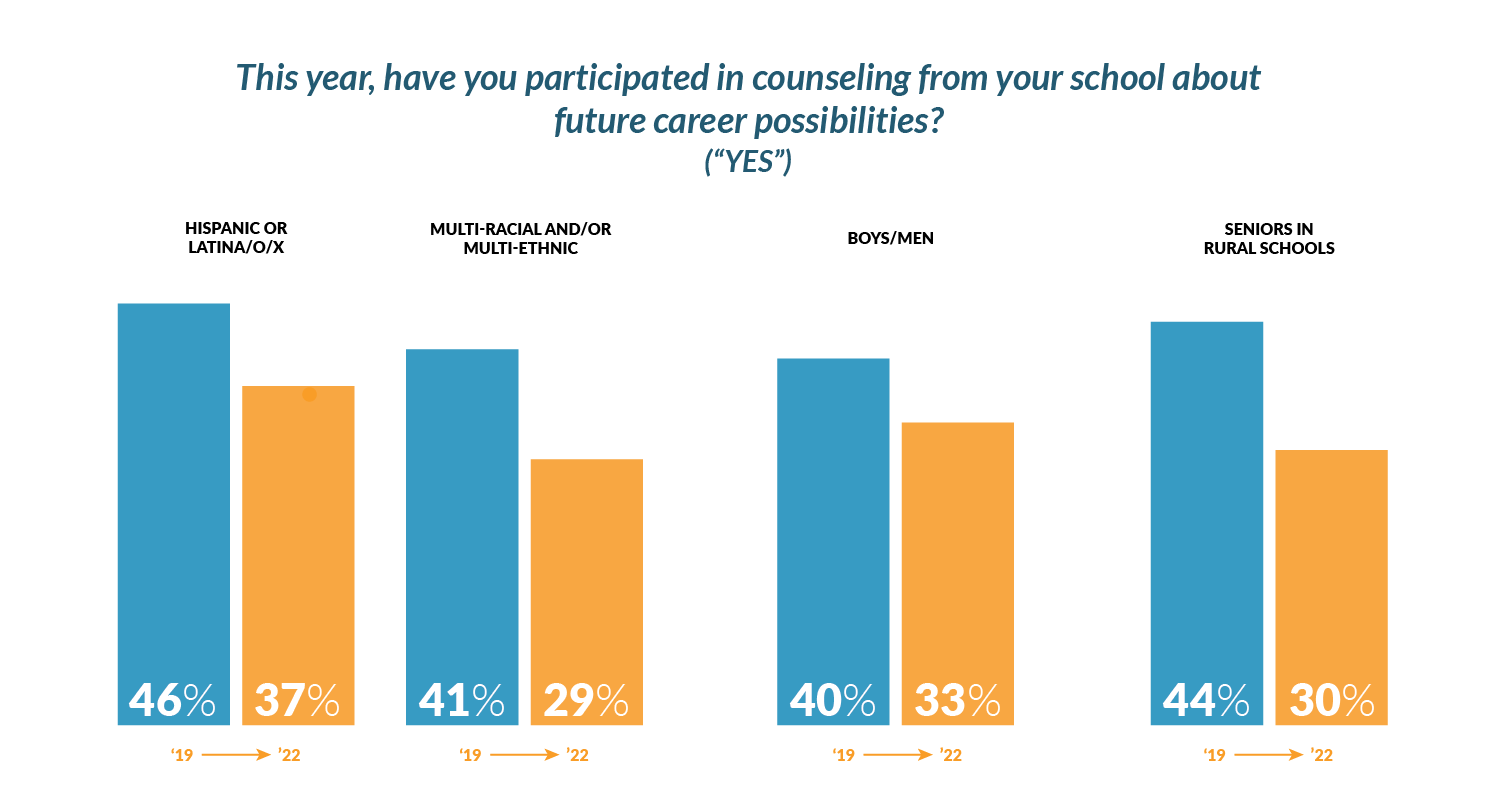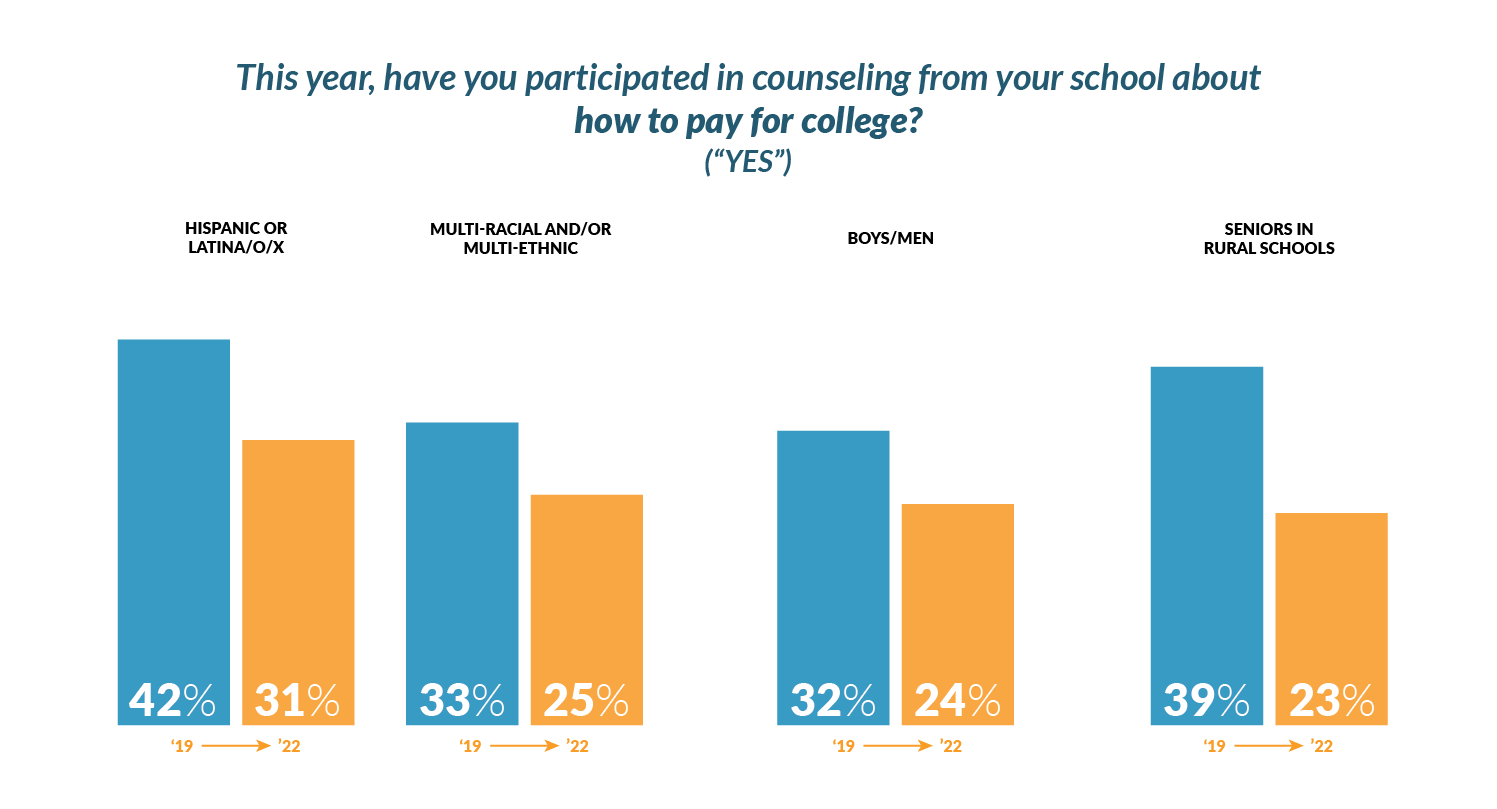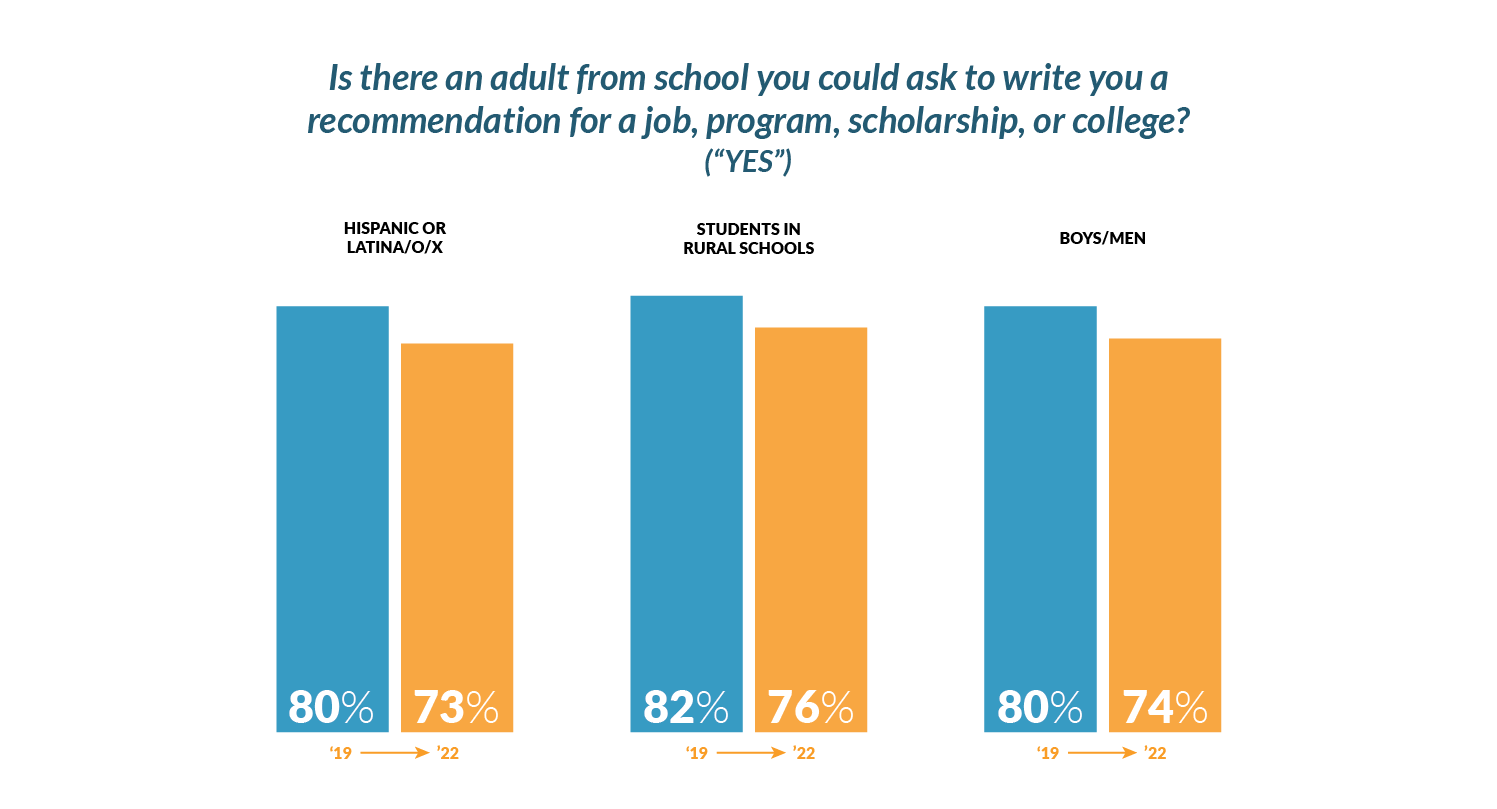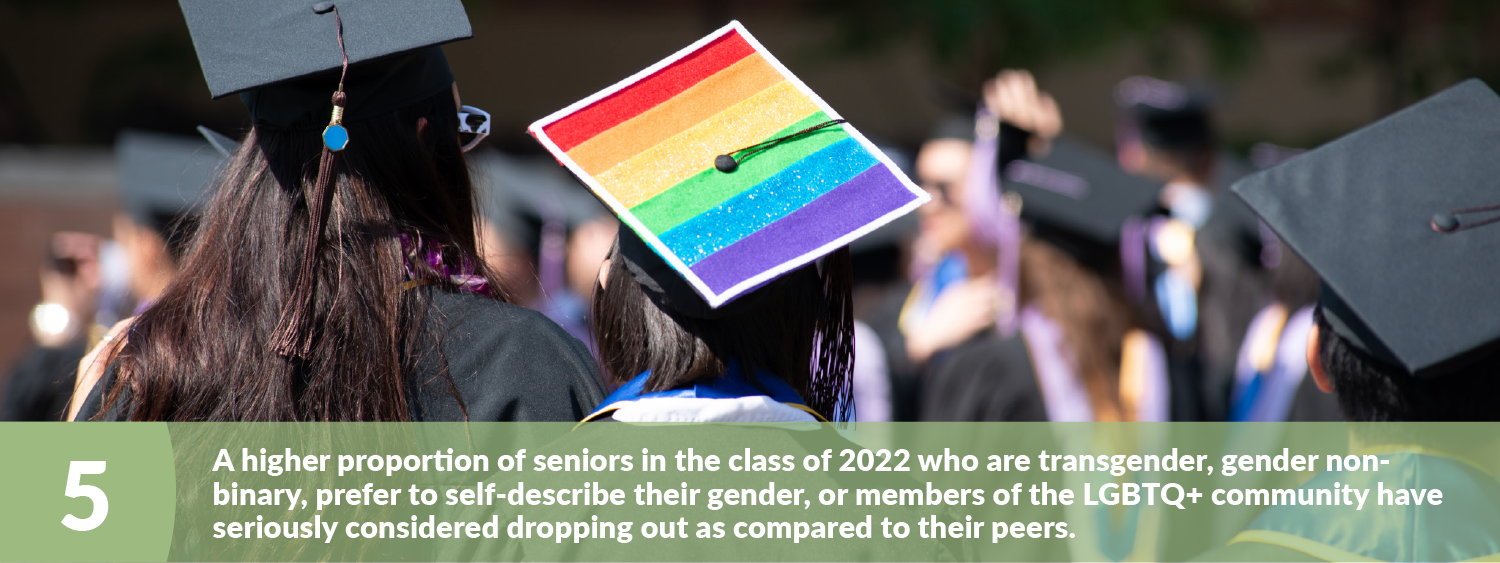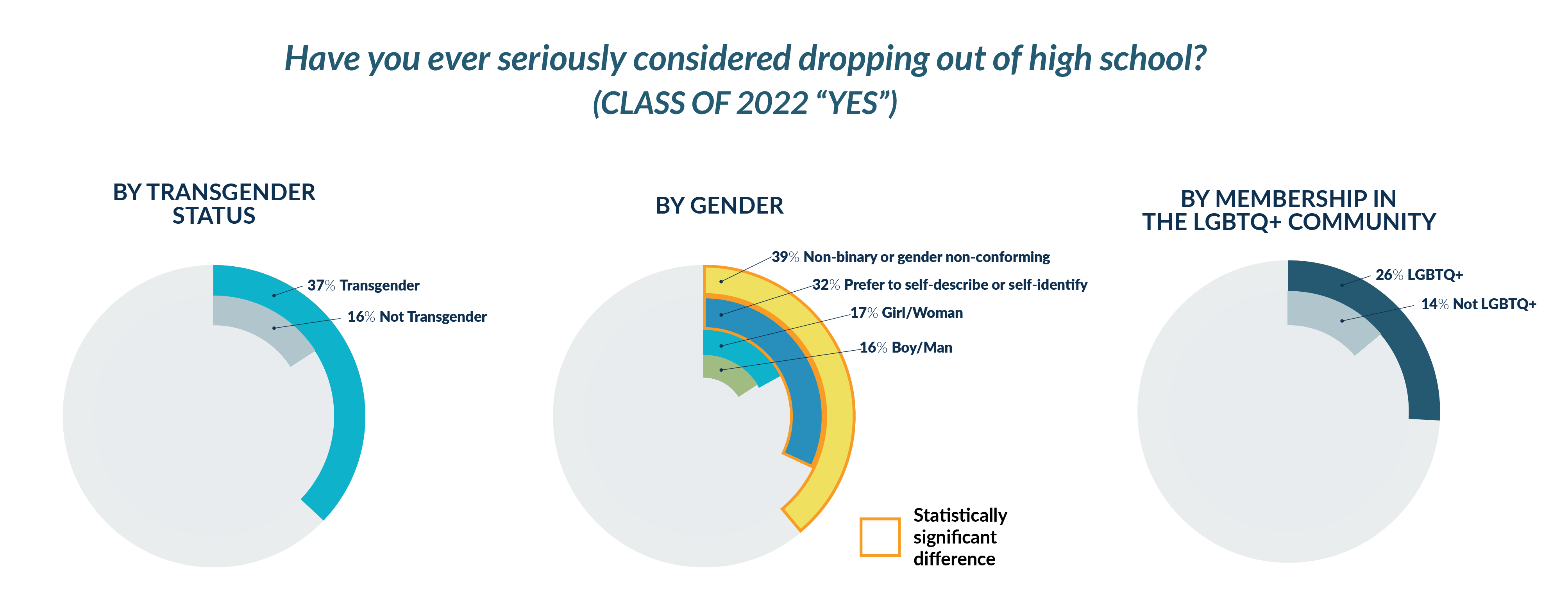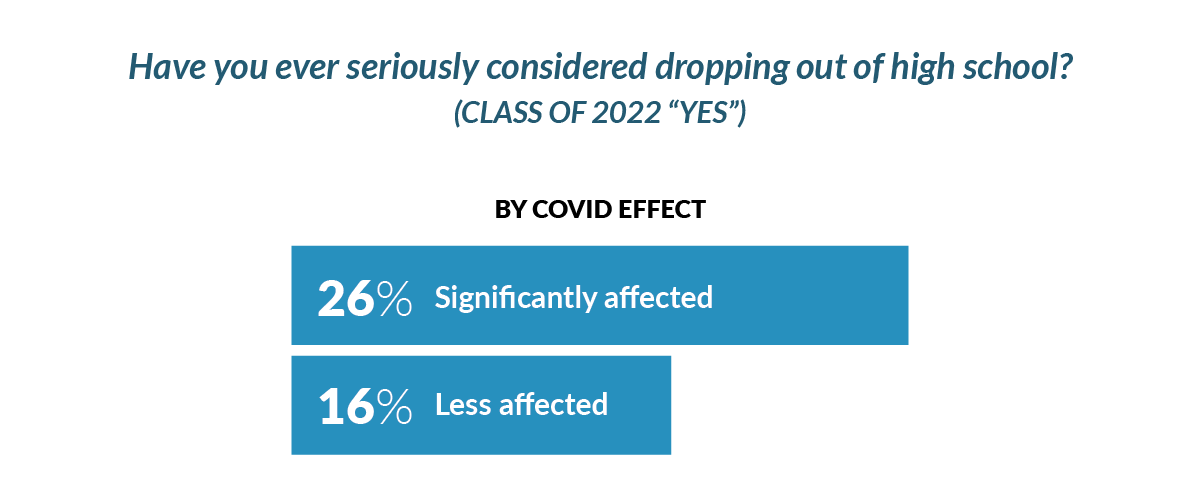
Introduction
The graduating class of 2022 has lived more than half of their high school career during the COVID-19 pandemic. Hearing directly from these graduating seniors about their future plans – including how those plans have changed and how they perceive support from their schools – can help school systems, employers, institutions of higher education, and students themselves better navigate this formative transition during uncertain times.
What do high school seniors in the class of 2022 have to say about their future plans? How do plans – and opportunities – differ across student demographic groups? And what has changed for this year’s graduates compared to the class of 2019, the last graduating class before the COVID-19 pandemic?
This report presents insights about future plans from over 28,000 high school seniors from the class of 2022 and the class of 2019. Surprisingly, across the 22 survey questions explored, only three revealed differences between these two groups of students overall: expecting to attend a two-year college, participating in counseling about future career possibilities, and participating in counseling about how to pay for college.
Notably, however, differences abound for certain groups of students, including Hispanic or Latinx students, Black or African American students, LGBTQ+ youth, boys/men, and students attending high-poverty schools, among others. These trends raise questions and concerns about how schools and their partners can inspire all students and better support them to thrive in college, career, and beyond.
Take Action
Contact us to learn more about how you can gather student feedback to drive improvements in your community.
Key Findings
Survey Sample
Survey Sample
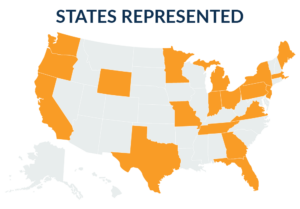 Throughout the fall and winter months of the 2021-2022 academic year, 22,219 high school seniors shared their perceptions of their school experiences and future plans through YouthTruth’s anonymous, research-based 15-minute online survey. The survey was administered in English and Spanish in partnership with 218 schools across 19 states.
Throughout the fall and winter months of the 2021-2022 academic year, 22,219 high school seniors shared their perceptions of their school experiences and future plans through YouthTruth’s anonymous, research-based 15-minute online survey. The survey was administered in English and Spanish in partnership with 218 schools across 19 states.
While the majority of this report focuses on the experiences and future plans of the graduating class of 2022, the full set of data explored is drawn from survey responses from 28,240 high school seniors across two time periods: 2021-2022 and 2018-2019. Across both time periods, we analyzed findings from seniors at 271 high schools across 119 school systems.
We selected these two time periods to understand the experiences of today’s high school seniors and the ways in which their experiences are similar to or different from the experiences of the last graduating class before the pandemic.
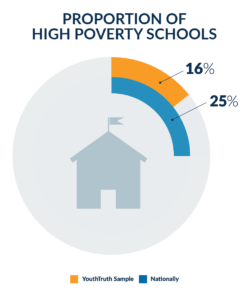 The student voices in this analysis are from a mix of urban (36 percent), suburban (46 percent), and rural settings (11 percent). Information was not available for the remaining seven percent. Sixteen percent of respondents attend high-poverty schools.
The student voices in this analysis are from a mix of urban (36 percent), suburban (46 percent), and rural settings (11 percent). Information was not available for the remaining seven percent. Sixteen percent of respondents attend high-poverty schools.
For the 94 percent of students who chose to self-identify their race/ethnicity, respondent demographics by race are shown right. The proportion of students who identify as a person of color in the 2022 dataset (the variable was not introduced until after 2019) is 36 percent (53 percent do not identify as a person of color, and 12 percent preferred not to say).
Methodology
Methodology
The survey data were examined using descriptive statistics and a combination of independent t-tests, chi-squares, and effect size testing. An alpha level of 0.05 was used to determine statistical significance, and effect sizes were examined for all analyses. Only analyses with at least a small effect size are reported. To explore change over time and differences between student demographic groups over time, a series of regressions were used, each controlling for student- and school-level characteristics across samples.
Indeed, more than one in four seniors in the class of 2022 – 28 percent – say their plans have changed since the start of the pandemic, and this is disproportionately experienced by certain student groups.
Overall, three out of four (74 percent) seniors in the class of 2022 report wanting to go to college, yet differences across student groups persist, and perceptions have changed for some groups over time.
Compared to their peers, a lower proportion of today’s Hispanic or Latinx seniors – 71 percent – and a higher proportion of Asian or Asian American students – 88 percent – say they want to go to college.
When asked, “After you finish high school, what do you expect to do next?” the majority of seniors in the class of 2022 report that they expect to attend a four-year college (47 percent) or two-year college (19 percent). About one in 10 (11 percent) are still not sure, eight percent plan to work a full-time job, six percent plan to do something other than the options listed, five percent plan to attend a trade or technical school, and four percent plan to join the military.
Uncertainty lingers, but not equally. Compared to their peers, a higher percentage of Hispanic or Latinx students – 14 percent – are unsure about what they expect to do next, while a lower percentage – just nine percent – of seniors who are white face such uncertainty.
Amid the strong job market and debate about the value of higher education – especially with COVID learning conditions still looming – eight percent of seniors in the class of 2022 are clear that their next step will be to work a full-time job. A higher percentage of English Language Learners (13 percent) expect to work a full-time job, as compared to just six percent of today’s seniors who are not English Language Learners. Additionally, a higher percentage of seniors in the class of 2022 who are boys/men (10 percent compared to six percent of their peers) and a higher percentage of Hispanic or Latinx seniors (10 percent compared to just seven percent of their peers) expect to work a full-time job.
As recently reported by NPR, while community college enrollment is down, skilled trade programs are seeing heightened interest. Yet in spite of efforts to diversify the skilled trade workforce, we still see that compared to their peers, a higher percentage of this year’s seniors who are boys/men (eight percent) and a lower percentage of girls/women (just three percent) expect to attend a trade or technical school.
Nearly half of seniors in the class of 2022 – 47 percent – report that they expect to attend a four-year college, yet differences by race, gender, language, ability, sexual orientation, and school poverty level reveal concerning expectation gaps.
A higher proportion of seniors in the class of 2022 who are Asian or Asian American (71 percent) or white (54 percent) expect to attend a four-year college as compared to their peers, while a lower proportion of seniors who are Hispanic or Latinx (36 percent) expect to attend a four-year college as compared to their peers, a sentiment that reflects a disquieting trend in higher education admissions.
Just 36 percent of seniors who receive special education support report that they expect to attend a four-year college, as compared to 53 percent who do not receive special education services.
Just one in three seniors this year who are English Language Learners (33 percent) say they expect to go to a four-year college, as compared to half (51 percent) of seniors who are not English Language Learners.
About 1 in 3 seniors this year who attend a high-poverty school (36 percent) plan to attend a four-year college, as compared to half (49 percent) of seniors who do not attend high-poverty schools.
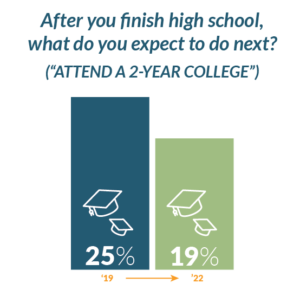 Disparities in college-going expectations for two-year colleges
Disparities in college-going expectations for two-year colleges
Today’s seniors are less likely to report that they expect to attend a two-year college than did seniors in the class of 2019. Just 19 percent of seniors this year report that they expect to attend a two-year college. This is down by six percentage points compared to the graduating class of 2019.
While two-year college plans have decreased overall, a higher percentage of seniors this year from some groups report plans to attend a two-year college compared to their peers.
A higher proportion of today’s seniors who are Hispanic or Latinx – 27 percent – and a lower percentage of seniors who are white – 15 percent – plan to attend a two-year college. Twenty-seven percent of today’s seniors who attend a high-poverty school plan to attend a two-year college after graduation as compared to just 18 percent of today’s seniors who do not attend a high-poverty school. And 22 percent of students who identify as a person of color plan to attend a two-year college after graduation as compared to 17 percent of today’s seniors who do not identify as a person of color.
Just one in three seniors in the class of 2022 report receiving counseling about future career possibilities and just one in four received counseling about how to pay for college. These are significant declines compared to the class of 2019 despite high helpfulness ratings for these support services across both time periods.
These meaningful declines may speak to the enormity of the job that is providing counseling services in a phase of covid recovery. With so much uncertainty about the future and ever-expanding caseloads, counseling resources are likely stretched thinner than ever.
Seniors in the class of 2022 who are Hispanic or Latinx as well as seniors who are multi-racial and/or multi-ethnic are less likely now to report having received counseling about career possibilities from their school compared to seniors from these groups in the class of 2019. Additionally, in 2019, 40 percent of seniors who are men/boys reported participating in counseling about future possibilities. That has dropped to just 33 percent among boys/men in the class of 2022. Finally, seniors at rural schools are now less likely to report receiving counseling for their career as compared to seniors graduating from rural schools in 2019 – 44 percent in 2019 as compared to just 30 percent in the class of 2022.
These trends for counseling about future career possibilities for Hispanic or Latinx students, multi-racial students, boys/men, and seniors attending rural schools extend to college financial counseling as well. Only 31 percent of seniors in the class of 2022 who are Hispanic or Latinx report participating in counseling about how to pay for college, compared to 42 percent in 2019. Only one in four of today’s seniors who are multi-racial and/or multi-ethnic say they have received college financial counseling compared to one in three in 2019. Similarly, boys/men in the class of 2022 are less likely to have participated in counseling about how to pay for college as compared to the class of 2019 (24 percent now versus 32 percent in 2019). Finally, seniors at rural schools are now less likely to report receiving counseling about how to pay for college (23 percent) as compared to seniors attending rural schools in the class of 2019 (39 percent).
The presence of a trusting adult at school is shown to support students’ academic and life outcomes. And key relationships that provide value (such as connections to jobs or referrals) can be both buffers against dropping out and boosts to students as they explore post-secondary pathways. It is therefore heartening to see that most seniors in the class of 2022 – 78 percent – report that there is an adult from school who they could ask to write a recommendation for a job, program, scholarship, or college. However, there are differences across student demographic groups.
A significantly higher proportion of seniors in the class of 2022 who are white – 84 percent – and a lower proportion of Hispanic or Latinx students – 73 percent – report that there is an adult from school who could write them a recommendation as compared to students of other races or ethnicities.
In addition, a lower percentage of boys/men (74 percent versus 82 percent of girls/women), English Language Learners (69 percent versus 81 percent of non-ELL), and students at high-poverty schools (71 percent versus 79 percent of their peers) report having an adult at school who would write them a recommendation.
Overall, 18 percent of seniors in the class of 2022 report that they’ve seriously considered dropping out of school. However, meaningful differences across student groups illustrate the formidable barriers that some students, particularly LGBTQ+ youth, face to making it across the podium.
Conclusion
Which students in the Class of 2022 want to go to college, a trade or technical school, to work, or to the military – and which students will be able to realize their aspirations? The insights from this year’s seniors shed light on what it has meant to navigate high school and to prepare for one’s future during a pandemic. And how these students are tackling their own futures is, of course, important to our collective future.
Particularly striking is the extent to which students’ sense of preparedness for the future has changed from 2019 to 2022 for certain groups of students, while much less has changed in the aggregate. The trends presented here around Hispanic or Latinx students, LQBTQ+ youth, and boys/men among others raise important questions for educators, college counselors, higher education admissions officers and institutions, policymakers and funders.
As we enter another season of high school graduations, a return to tradition will surely mark a time of celebration for many students, families, and schools. At the same time it is an important moment to pause and recognize that this is a wholly unusual season, making it even more critical that we tune into the voices and experiences of those for whom our education system is designed: students.
We hear you.
